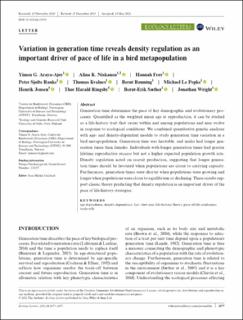| dc.contributor.author | Araya-Ajoy, Yimen | |
| dc.contributor.author | Niskanen, Alina Katariina | |
| dc.contributor.author | Froy, Hannah | |
| dc.contributor.author | Ranke, Peter Sjolte | |
| dc.contributor.author | Kvalnes, Thomas | |
| dc.contributor.author | Rønning, Bernt | |
| dc.contributor.author | Pepke, Michael Le | |
| dc.contributor.author | Jensen, Henrik | |
| dc.contributor.author | Ringsby, Thor Harald | |
| dc.contributor.author | Sæther, Bernt-Erik | |
| dc.contributor.author | Wright, Jonathan | |
| dc.date.accessioned | 2022-02-08T12:15:42Z | |
| dc.date.available | 2022-02-08T12:15:42Z | |
| dc.date.created | 2021-09-22T11:43:34Z | |
| dc.date.issued | 2021 | |
| dc.identifier.citation | Ecology Letters. 2021, 24 2077-2087. | en_US |
| dc.identifier.issn | 1461-023X | |
| dc.identifier.uri | https://hdl.handle.net/11250/2977709 | |
| dc.description.abstract | Generation time determines the pace of key demographic and evolutionary processes. Quantified as the weighted mean age at reproduction, it can be studied as a life-history trait that varies within and among populations and may evolve in response to ecological conditions. We combined quantitative genetic analyses with age- and density-dependent models to study generation time variation in a bird metapopulation. Generation time was heritable, and males had longer generation times than females. Individuals with longer generation times had greater lifetime reproductive success but not a higher expected population growth rate. Density regulation acted on recruit production, suggesting that longer generation times should be favoured when populations are closer to carrying capacity. Furthermore, generation times were shorter when populations were growing and longer when populations were closer to equilibrium or declining. These results support classic theory predicting that density regulation is an important driver of the pace of life-history strategies. | en_US |
| dc.language.iso | eng | en_US |
| dc.publisher | Wiley | en_US |
| dc.rights | Navngivelse-Ikkekommersiell 4.0 Internasjonal | * |
| dc.rights.uri | http://creativecommons.org/licenses/by-nc/4.0/deed.no | * |
| dc.title | Variation in generation time reveals density regulation as an important driver of pace of life in a bird metapopulation | en_US |
| dc.type | Journal article | en_US |
| dc.type | Peer reviewed | en_US |
| dc.description.version | publishedVersion | en_US |
| dc.source.pagenumber | 2077-2087 | en_US |
| dc.source.volume | 24 | en_US |
| dc.source.journal | Ecology Letters | en_US |
| dc.identifier.doi | 10.1111/ele.13835 | |
| dc.identifier.cristin | 1937050 | |
| dc.relation.project | Norges forskningsråd: 191847 | en_US |
| dc.relation.project | Norges forskningsråd: 302619 | en_US |
| dc.relation.project | Norges forskningsråd: 221956 | en_US |
| dc.relation.project | Norges forskningsråd: 223257 | en_US |
| dc.relation.project | Norges forskningsråd: 274930 | en_US |
| cristin.ispublished | true | |
| cristin.fulltext | original | |
| cristin.qualitycode | 2 | |

